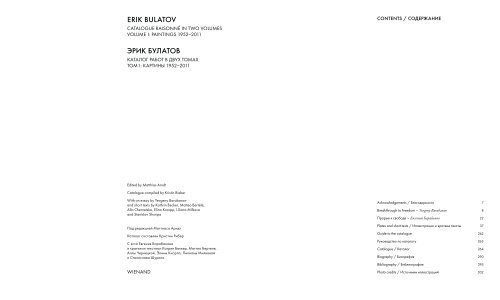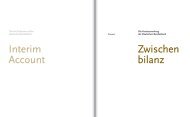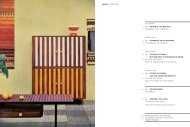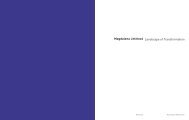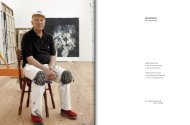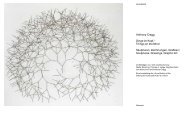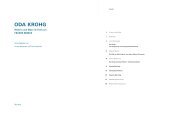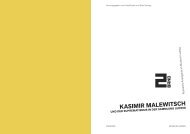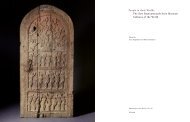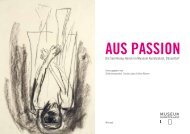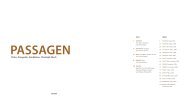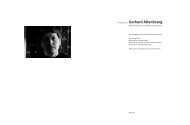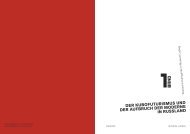ERIK BULATOV ſŲŪŬ ţŵŭŢŴŰŤ
ERIK BULATOV ſŲŪŬ ţŵŭŢŴŰŤ
ERIK BULATOV ſŲŪŬ ţŵŭŢŴŰŤ
Create successful ePaper yourself
Turn your PDF publications into a flip-book with our unique Google optimized e-Paper software.
<strong>ERIK</strong> <strong>BULATOV</strong><br />
CATALOGUE RAISONNÉ IN TWO VOLUMES<br />
VOLUME I� �AINTINGS ���������<br />
���� �������<br />
������� ����� � ���� �����<br />
��� I� ������� ���������<br />
Edited by Matthias Arndt<br />
Catalogue compiled by Kristin Rieber<br />
With an essay by Yevgeny Barabanov<br />
and short texts by Kathrin Becker, Matteo Bertelé,<br />
Alla Chernetska, Elina Knorpp, Liliana Milkova<br />
and Stanislav Shuripa<br />
��� ��������� �������� �����<br />
������� ��������� ������� �����<br />
� ���� ������� ����������<br />
� ��a����� �������� ������ ������, ������ �������,<br />
���� ���������, ����� ������, ������� ��������<br />
� ���������� ������<br />
WIENAND<br />
�O�TE�T� � ����������<br />
Ackno�ledgements � ������������� 7<br />
Breakthrough to Freedom – Yevgeny Barabanov 8<br />
������ � ������� – Евгений Барабанов 22<br />
�lates and short texts � ����������� � ������� ������ 37<br />
Guide to the catalogue 262<br />
����������� �� �������� 263<br />
Catalogue � ������� 264<br />
Biography � ��������� 2��<br />
Bibliography � ������������ 295<br />
�hoto credits � ��������� ����������� 3�2
8<br />
BREAKTHROUGH TO FREEDOM<br />
Yevgeny Barabanov<br />
freedom is<br />
freedom is<br />
freedom is<br />
freedom is<br />
freedom is<br />
freedom is<br />
freedom is freedom<br />
Vsevolod Nekrasov<br />
Erik Bulatov is a central figure in Russian contemporary art. The reassessment<br />
of the tasks of painting he undertook half a century ago<br />
led him, along with other enthusiasts who followed in his wake, to a<br />
new view of the artistic profession, modernity, and art itself. Although<br />
the epithet “classic” is now attached to his name, the ultimate significance<br />
of this reassessment itself, as embodied in Bulatov’s artistic and<br />
theoretical legacy, has not yet been exhaustively interpreted by researchers.<br />
One thing is irrefutable: with his original art, Bulatov has<br />
accomplished the impossible. He took up the challenge of the Soviet<br />
modernity he was confronted with and, without hiding from it, without<br />
turning away from the totality of its indoctrination, opened doors<br />
into a world of freedom, into a world that enabled him to link art’s past<br />
with its future.<br />
It has been at the crossroads of the classical past, the avant-garde,<br />
ideological kitsch, and innovation that the problematics of Bulatov’s<br />
art – the problematics of the picture – has been tested.<br />
The question of the picture remains suspended in today’s critical<br />
consciousness. For some critics and artists, the picture is a commercial<br />
product that has outlived its age. For others, it is an arbitrary object just<br />
as arbitrarily dubbed “picture.” For still others, it is an occasion for simulative<br />
practices. For Bulatov, however, the picture continues to be part<br />
of a basic experience of trust in the world, with all the existential, ontological,<br />
cultural, and anthropological implications that follow from<br />
that trust. For Bulatov, the picture is a foothold, an opportunity for<br />
encounter, dialogue, recognition, understanding, and self-knowledge.<br />
The absence of naïveté in this stance, a naïveté that from the<br />
outset has been deflected by a consistent theoretical self-consciousness,<br />
has often moved Russian critics to detect in Bulatov’s work<br />
“ludic strategies” combining the techniques of, say, photorealism<br />
with the constructivist poster or mass media production. Moreover,<br />
the thematics of his pictures and the presence therein of elements of<br />
Soviet propaganda have long been interpreted in terms of Sots Art. 1<br />
Hence, Bulatov has been ranked both among the modernists and the<br />
postmodernists. 2<br />
Here we should immediately note that what Erik Bulatov was<br />
the first to undertake on the eve of the 1970s was of course not Sots<br />
Art, neither in the sense that it acquired in the subsequent ventures<br />
of Komar and Melamid, nor in the sense of a combinatory polystylistics,<br />
a masquerade-like doubling that employs fictional “artists”<br />
as its “characters” (a program absent in Bulatov’s work), nor in the<br />
sense of a Bakhtinian “carnivalization,” that is, a grassroots culture of<br />
folkloric jokes made at the expense of ideological symbols. In Bulatov’s<br />
work, the social dimension is represented in all seriousness: he does<br />
not employ an alien idiom to mock it. There is no irony in his work;<br />
irony is replaced by distance, by a viewpoint that enables him to see<br />
and recognize things, to give them names and images. Bulatov is not<br />
an eclecticist, and therefore his work is bereft of postmodernist pastiche,<br />
simulacra, and imitations of classicism. For him, the picture is<br />
an opportunity to defend the reality of art on the frontier between life<br />
and its devastation.<br />
The seriousness with which Bulatov has taken the theoretical<br />
bases of his stance has encouraged attempts to rank him among the<br />
conceptualists. 3 If what is meant here is concept art, then he makes<br />
no attempt to situate his art “after philosophy,” that is, after the philosophy<br />
of art, after the aesthetics of the painting, as Joseph Kosuth<br />
called on artists to do. Bulatov has never tried to replace the traditional<br />
image with its technical counterpart, to replace the colored pencil<br />
or paint brush with extra-pictorial realia – with texts, photographs,<br />
objects or actions. On the contrary, he has consistently defended the<br />
value and relevance of the picture. He has done much to overcome the<br />
aestheticism and aestheticization of “French painting,” but he considers<br />
the denial of aesthetics itself naive. 4<br />
It is obvious that instead of the empty and, in our case, meaningless,<br />
one-size-fits-all word “conceptualism,” it would be more correct<br />
to speak of conceptualization – that is, of the construction of particular<br />
models of pictorial space vis-à-vis the picture as thing and the perceptual<br />
experience of the picture’s artistic world. This perhaps sounds<br />
a bit old-fashioned, but it brings us noticeably closer to the essence of<br />
the matter, to the intentions, tasks, and problems that Bulatov himself<br />
is concerned with.<br />
1 See Margarita Tupitsyn, “Sots Art: The Russian Deconstructive Force,” in Margarita<br />
Tupitsyn, et al., Sots Art, exh. cat. New Museum of Contemporary Art, New York, et al.<br />
(New York, 1986), pp. 4–15 [on Bulatov pp. 7–8, 106]. The characterization of Bulatov<br />
as Sots Artist can also be found in concise form: “Erik Bulatov is today considered a leading<br />
representative of the so-called ‘Sots-art.’” Eric A. Peschler, Ateliers de Moscou: Dessins<br />
contemporains (Paris: Enrico Navarra – Galerie de France, 1989), p. 37.<br />
2 Е. Andreeva, Postmodernizm. Iskusstvo vtoroi poloviny XX–nachala XXI veka (Saint<br />
Petersburg: Azbuka-Klassika, 2007), pp. 210–211.<br />
3 “Bulatov is one of the key names in Moscow conceptualism.” I. Kulik, “Govorit i pokazyvaet<br />
Erik Bulatov. Retrospektiva zhivopistsa-nonkonformista v Tret’iakove,” Kommersant,<br />
September 21, 2006, p. 13.<br />
4 V. Tupitsyn, “Erik Bulatov,” in V. Tupitsyn, “Drugoe” iskusstvo. Besedy c khudozhnikami,<br />
kritikami, filosofami: 1980–1995 gg. (Moscow: Ad Marginem, 1997), pp. 66–67.<br />
We should remember that we are dealing with a wholly original,<br />
tremendously important artist who has achieved a supreme level<br />
of artistic maturity, definition, perfection, and formal precision. In<br />
Bulatov’s work, there is none of the coyness, ambiguity, pretentious<br />
striving after literary effects or mystical fogginess that in contemporary<br />
art so often conceals an ambitious incompetence. On the contrary,<br />
Bulatov is an artist capable of formulating general problems<br />
and articulating his own tasks with utter clarity and responsibility.<br />
The same can be said of his system of self-interpretation, which is<br />
least of all a makeweight to the work itself. Its function is to limit all<br />
forms of indeterminacy, and that is why it is directed both towards<br />
integration and differentiation. And because any form of integration<br />
consists of differentiations, Bulatov is particularly attentive to the latter.<br />
Moreover, the system of differences he has introduced encompasses<br />
not only the specifics of the works themselves, but also the premises<br />
and rules of their hermeneutics, which are generated in dialogue with<br />
the picture, with tradition, with the viewer. The agency of the viewer<br />
is particularly important: Bulatov’s system of unities and differences is<br />
an open system albeit one that seems, to some, paradoxical; however,<br />
it excludes all ambivalence. Hence, the desire to reduce indeterminacy<br />
also gives rise to more basic distinctions signaled to the outside world,<br />
to those negative self-definitions on which Bulatov never tires of insisting:<br />
that his work is not modernism, not Sots Art, not hyper- (or<br />
photo-) realism, not mass media.<br />
We should begin our brief resume of Bulatov’s life with this elucidatory<br />
“not.”<br />
1. MOSCOW – PARIS<br />
Bulatov is not from the Urals. Although he was born in Sverdlovsk<br />
(now known as Yekaterinburg) in 1933, his parents were Muscovites.<br />
After his father returned to the capital from an assignment in<br />
Sverdlovsk, Bulatov grew up, studied, and then worked in Moscow<br />
right up until his emigration from the Soviet Union in the late 1980s.<br />
From 1947 to 1952, he studied at the Moscow Arts Middle School<br />
(MSKhSh) and after graduation in the painting department at the<br />
Surikov Art Institute in Moscow. These educational institutions remained<br />
the most prestigious strongholds of Soviet academic art right<br />
up until the fall of communism.<br />
However, the decisive role in Bulatov’s formation as an artist was<br />
played by two men – the painter Robert Falk (1886–1958), whom<br />
Bulatov met in 1952, and Vladimir Favorsky (1886–1964), a graphic<br />
artist, master book illustrator, original thinker, and art theorist whom<br />
Bulatov met in 1956.<br />
Both Falk and Favorsky emerged as artists during the avant-garde<br />
period. Later, during the 1920s, both men taught at the renowned<br />
Vkhutemas/Vkhutein in Moscow. Finally, both were denounced as<br />
“formalists” by semi-official doctrinaires and shunted to the sidelines<br />
of artistic life. Recognition of their significance, role, scale, and<br />
indisputable achievements in Russian art came only gradually, with<br />
the advent of the Khrushchev Thaw. Both Falk and Favorsky formed<br />
original artistic systems based on a profound knowledge of the latest<br />
tendencies in European art, as well as a critical reassessment of them.<br />
Favorsky studied in Munich in 1906–1907 and, later, in the art history<br />
department of Moscow University; he translated the theoretical<br />
texts of the sculptor Adolf Hildebrand as well as Karl Voll’s book<br />
Comparative Studies of Paintings. 5 Falk, an adherent of Cézanne and<br />
the Cubists, was a member of the Jack of Diamonds group. Later,<br />
from 1928 to 1937, he lived and worked in Paris, where he had been<br />
sent originally (for a much shorter term) to study “classical art.” This,<br />
however, did not prevent him from becoming intimately familiar<br />
with all the significant phenomena in the artistic life of this period.<br />
Falk’s conversations with the student Bulatov, and their viewing<br />
and critique of work (this all began while Stalin was still alive!) were<br />
a defining moment for Bulatov. “I essentially got my understanding<br />
of French art (and all French culture in general) from Falk. But perhaps<br />
what was more important was that Falk became for me an exemplar<br />
of how the artist should conduct himself in social space. He<br />
had no opportunity to exhibit his works, and as an artist he lived in<br />
total isolation. Official critics pretended that there was no such artist.<br />
And without fuss, without becoming indignant, without trying<br />
to adapt, not reacting to anything, he went on with his work, peaceful<br />
and focused. I think that Falk was the only member of his generation<br />
of artists who not only did not regress during those years, but, on the<br />
contrary, worked better than he previously had.” 6<br />
Bulatov continued to master Falk’s painterly principles and, occasionally,<br />
up until 1961, to imitate his manner. Thereafter, and right<br />
up to the present day, the place of the teacher in Bulatov’s life has been<br />
occupied by Vladimir Favorsky. For Bulatov, it was no longer a matter<br />
of overcoming the deadening academicism of socialist realist painting<br />
as much as it was a matter of developing his own problematics, his own<br />
artistic system.<br />
Bulatov did not imitate Favorsky, nor did he even show him his<br />
works. Instead he would go to the patriarch of Moscow art to ask questions.<br />
The master’s answers, which were grounded in his own artistic<br />
practices, a profound analysis of the spatiality of artworks, and, finally,<br />
his rich experience as a teacher, introduced Bulatov not so much to<br />
readymade solutions as to methodological self-consciousness, to a clear<br />
sense of one’s own work and the how, what, and why of the work done<br />
by others. Under Favorsky’s tutelage, Bulatov mastered and rethought<br />
principles, not techniques.<br />
Bulatov’s encounter with Falk and Favorsky marked the beginning<br />
of a thoroughgoing process of re-education – a conscious overcoming<br />
of the doctrines and methods of socialist realist painting. Along with<br />
this re-education, Bulatov formulated his own problematics as an artist:<br />
the problematics of the picture as a multi-dimensional spatial universe.<br />
This was least of all a quest for formal solutions. The question of<br />
the picture – its potential, place, and role in art – became the content<br />
of Bulatov’s life, a means of self-understanding, a way to reflect on existential,<br />
metaphysical, and social questions. It goes without saying that<br />
this interpretation of the picture and his own mission in life inevitably<br />
distanced him from a successful career as a Soviet painter.<br />
5 A. Gil’debrand, Problema formy v izobrazitel’nom iskusstve, trans. N. B. Rozenfel’d and<br />
V. A. Favorskii (Moscow: Musaget, 1914) [Russian translation of Adolf Hildebrand,<br />
Das Problem der Form in der Bildenden Kunst (Straßburg: Heitz, 1901)]; K. Foll’, Opyt<br />
sravnitel’nogo izucheniia kartin, trans. N. B. Rozenfel’d and V. A. Favorskii (Moscow:<br />
Izdatel’stvo G. A. Lemana i S. I. Sakhorova, 1916) [Russian translation of Karl Voll, Vergleichende<br />
Gemäldestudien (Munich: Müller, 1907)].<br />
6 E. Bulatov, “Avtobiografiia,” in E. Bulatov, Zhivu dal’she (Moscow: Artist. Rezhisser.<br />
Teatr, 2009), p. 12.<br />
9
22<br />
������ � �������<br />
Евгений Барабанов<br />
свобода есть<br />
свобода есть<br />
свобода есть<br />
свобода есть<br />
свобода есть<br />
свобода есть<br />
свобода есть свобода<br />
Всеволод Некрасов<br />
Эрик Булатов – фигура в современном русском искусстве центральная.<br />
Предпринятая им еще полвека назад переоценка задач живописи<br />
привела его, а вслед за ним и других энтузиастов, к новому<br />
взгляду на дело художника, на современность, на само искусство.<br />
Теперь его имени сопутствует эпитет «классик», хотя<br />
итоговое значение самой переоценки, воплощенной в художественном<br />
и теоретическом наследии Булатова, еще не нашло обстоятельных<br />
исследовательских толкований. Неоспоримо одно:<br />
своим оригинальным искусством художник совершил невозможное:<br />
принял вызов выпавшей на его долю советской современности<br />
и, не прячась от нее, не отворачиваясь от тотальности<br />
ее внушений, открыл двери в мир свободы – мир, позволивший<br />
ему связать прошлое искусства с его будущим.<br />
На этом скрещении путей – классического прошлого, авангарда,<br />
идеологического китча и новаторства – и проверялась собственная<br />
проблематика искусства Булатова – проблематика картины.<br />
Вопрос о картине в сегодняшнем критическом сознании<br />
остается подвешенным. Для одних речь идет о пережившем<br />
свой век коммерческом продукте, для других – о произвольном<br />
объекте, столь же произвольно именуемом картиной, для третьих<br />
– о поводе для симулятивных практик. Однако для Булатова<br />
картина по-прежнему принадлежит базисному опыту доверия<br />
к миру, со всеми его экзистенциальными, онтологическими<br />
и культурно-антропологическими экспликациями. Картина<br />
для него – точка опоры, возможность встречи, диалога, узнавания,<br />
понимания и самопонимания.<br />
Отсутствие в такой позиции наивности, исходно оттесненной<br />
последовательной теоретической рефлексией, нередко<br />
побуждает российских критиков видеть в творчестве Булатова<br />
«игровые стратегии», основанные на соединении приёмов, скажем,<br />
фотореализма с конструктивистским плакатом или массмедийной<br />
продукцией. При этом тематика его картин, наличие<br />
в них визуальных элементов советской пропаганды уже давно<br />
толковались в духе соц-арта. 1 Отсюда – причисление его то к модернистам,<br />
то – к постмодернистам. 2<br />
Здесь необходимо сразу отметить: то, что Булатов начал<br />
первым делать на пороге семидесятых, конечно же, соц-артом<br />
не является: ни в значении последующих инициатив Комара и<br />
Меламида, ни в контексте отсутствующих у Булатова программ<br />
комбинаторной полистилистики, маскарадных удвоений с помощью<br />
выдуманных «персонажных художников», ни в контексте<br />
бахтинской «карнавализации» – низовой культуры фольклорных<br />
шуток над идеологической символикой. У Булатова<br />
социальное измерение представлено во всей серьезности; он не<br />
пользуется чужим языком осмеяний; у него нет иронии, её заменяет<br />
дистанция: точка зрения, позволяющая увидеть и распознать,<br />
дать имя, образ. Булатов – не эклектик, поэтому у него нет<br />
ни постмодернистского пастиша, ни симулякров, ни имитаций<br />
классицизма. Картина для него – возможность отстаивать реальность<br />
искусства на границе жизни и ее опустошения.<br />
Серьезность, с которой Булатов отнесся к теоретическим<br />
обоснованиям своей позиции, стимулировала попытки зачисления<br />
его в ряды концептуалистов. 3 Если иметь в виду concept art – у<br />
Булатова нет никаких попыток поставить свое искусство «после<br />
философии», то есть после философии искусства, после эстетики<br />
картины, как призывал к тому Кошут. Булатов никогда не<br />
пытался заменить традиционный образ техническим, цветной<br />
карандаш или кисть – внекартинной деятельностью: текстами,<br />
фотографиями, объектами, акциями. Напротив, он последовательно<br />
отстаивает ценность и актуальность картины. Он много<br />
сделал для преодоления эстетизма и эстетизации «французской<br />
живописи», но считает наивным само отрицание эстетики. 4<br />
Очевидно, вместо бессодержательного, в нашем случае<br />
ничего не значащего безразмерного слова «концептуализм»,<br />
правильнее говорить о концептуализации как о построении<br />
1 M. Tupitsyn. Sots Art: The Russian Deconstructive Force. // Sots Art. The New Museum<br />
of Contemporary Art, New York, April 12–June 12, 1986, pp. 4–15 [о Булатове pp. 7–8;<br />
тот же пассаж повторен: М. Тупицына. От Соцарта к Соварту. Заметки о московском<br />
альтернативном искусстве. // Флэш Арт. Русское издание. 1989, № 1, с. 106];<br />
русск. перевод текста 1986 года: М. Тупицына. Критическое оптическое. Статьи о<br />
современном русском искусстве. М., Ad Marginem, 1997, с. 40–62. Квалификацию<br />
Булатова как художника соц-арта можно встретить и в кратких формулах: например,<br />
«Эрик Булатов считается сегодня ведущим представителем так называемого<br />
“соц-арта”» (Eric A. Peschler. Ateliers de Moscou Dessins contemporains. Paris, Enrico<br />
Navarra – Galerie de France, 1989, p. 37).<br />
2 Е. Андреева. Постмодернизм. Искусство второй половины ХХ – начала XXI века.<br />
СПб., Азбука-Классика, 2007, с. 210–211.<br />
3 «Булатов – одно из ключевых имен московского концептуализма» (И. Кулик. Говорит<br />
и показывает Эрик Булатов. Ретроспектива живописца-нонконформиста в<br />
Третьяковке. // Коммерсант, 2006, № 176, 21 сентября, с. 13).<br />
4 В. Тупицын. «Другое» искусства. Беседы с художниками, критиками, философами:<br />
1980–1995 гг. М., Ad Marginem, 1997, с. 66–67.<br />
особых моделей пространства картины в соотношении с картиной-вещью<br />
и перцептуальным опытом восприятия художественного<br />
мира картины. Это, быть может, выглядит несколько<br />
старомодно, однако куда заметнее приближает к сути дела – к<br />
тем намерениям, задачам и проблемам, которыми озабочен сам<br />
художник.<br />
Следует помнить: мы имеем дело с всецело оригинальным<br />
художником огромного масштаба, достигшим высочайшего<br />
уровня художественной завершенности, определенности, законченности,<br />
точности формы. Никакой недоговоренности,<br />
двусмысленности, претенциозной литературщины или мистического<br />
тумана, за которыми в современном искусстве так часто<br />
прячется амбициозная несостоятельность. Напротив, Булатов<br />
– художник, способный предельно ясно, с внимательной ответственностью<br />
формулировать общие проблемы и артикулировать<br />
собственные задачи.<br />
То же относится к его системе самоинтерпретации. Менее<br />
всего это «довесок» к творчеству. Её назначение – в ограничении<br />
всякой неопределенности. Именно потому она нацелена<br />
разом и на интеграцию, и на дифференциацию. А поскольку всякая<br />
интеграция конституируется дифференциациями, именно<br />
к ним-то особенно внимателен Булатов. При этом введенная им<br />
система различий охватывает не только специфику самих работ,<br />
их последовательность и взаимозависимость, но также предпосылки<br />
и правила их герменевтики, рожденные в диалоге с картиной,<br />
традицией, зрителем. Инстанция зрителя особенно важна:<br />
авторская система единств и различий – система открытая, для<br />
кого-то парадоксальная, однако исключающая всякую двусмысленность.<br />
Отсюда – из стремления к уменьшению неопределенности<br />
– следуют и более общие, направленные во вне сигналы<br />
базисных отличий: те не самоопределений, на которых не устает<br />
настаивать Булатов: …не модернизм, не соц-арт, не гипер-(фото)<br />
реализм, не масс-медиа …<br />
С разъяснительного не следует начать и краткую биографическую<br />
справку.<br />
1. ������ – �����<br />
Не уралец: хотя Эрик Булатов родился в 1933 году в Свердловске<br />
(ныне Екатеринбург) – родители его москвичи. После возвращения<br />
из свердловской командировки отца в столицу – Булатов<br />
рос, учился, затем работал в Москве вплоть до переезда за границу<br />
в конце восьмидесятых.<br />
С 1947 по 1952 год Булатов – ученик Московской средней<br />
художественной школы (МСХШ); после ее окончания – студент<br />
живописного факультета Московского художественного института<br />
имени В.И. Сурикова. Эти учебные заведения оставались<br />
самыми престижными инстанциями советского академического<br />
искусства вплоть до падения коммунизма.<br />
Однако решающую роль в формировании Булатова-художника<br />
сыграло знакомство зимой 1952 года с живописцем Робертом<br />
Рафаиловичем Фальком (1886–1958), а в 1956-м – с графиком,<br />
мастером искусства книги, оригинальным мыслителем,<br />
теоретиком искусства Владимиром Андреевичем Фаворским<br />
(1886–1964).<br />
Становление Фалька и Фаворского принадлежало эпохе<br />
авангарда; позже, в двадцатые годы, оба преподавали в знаменитом<br />
Вхутемасе-Вхутеине; наконец, оба были причислены<br />
официозными доктринёрами к «формалистам» и оттеснены<br />
на периферию художественной жизни. Признание их значения,<br />
роли, масштаба, неоспоримых заслуг в отечественном искусстве<br />
стало медленно приходить к ним лишь с хрущевской «оттепелью».<br />
И Фальк, и Фаворский сформировали оригинальные<br />
художественные системы, основанные как на глубоком усвоении<br />
новейших европейских художественных тенденций, так<br />
и на критическом их пересмотре: в 1906–1907 гг. Фаворский<br />
учился в Мюнхене, позже – на искусствоведческом факультете<br />
Московского университета, перевёл теоретическое сочинение<br />
скульптора Адольфа Гильдебранда, книгу Карла Фолля «Опыт<br />
сравнительного изучения картин», 5 а Фальк – последователь<br />
Сезанна и кубистов – входил в знаменитое объединение «Бубновый<br />
валет». Позже, с 1928 по 1937 год, Фальк был командирован<br />
во Францию «с целью изучения классического искусства»,<br />
что, однако, не помешало ему близко познакомиться со<br />
всеми значительными явлениями художественной жизни той<br />
поры.<br />
Беседы Булатова-студента с Фальком, просмотр и обсуждение<br />
работ (всё началось еще при жизни Сталина!) оказались<br />
определяющими: «По сути, понимание французского искусства,<br />
да и вообще всей французской культуры, – вспоминает<br />
Эрик Булатов, – я получил от Фалька. Но, может быть, еще более<br />
важным было то, что Фальк стал для меня образцом поведения<br />
художника в социальном пространстве. Он не имел возможности<br />
выставлять свои работы и существовал как художник в<br />
полной изоляции. Официальная критика делала вид, что такого<br />
художника не существует. А он, не суетясь, не возмущаясь, не<br />
стараясь приспособиться, спокойно и сосредоточенно работал,<br />
не реагируя ни на что. Я думаю, Фальк был единственным из<br />
художников его поколения, кто не только не деградировал в те<br />
годы, но, напротив, работал лучше, чем прежде». 6<br />
Период освоения живописных принципов Фалька, порой<br />
подражания ему продолжался до 1961 года. Затем – и по сей<br />
день! – место учителя занял для Булатова Владимир Андреевич<br />
Фаворский. Теперь речь шла не столько о преодолении мертвящего<br />
академизма соцреалистической живописи, сколько о<br />
формировании собственной проблематики, собственной художественной<br />
системы.<br />
Булатов не подражал Фаворскому, даже не показывал ему<br />
своих работ. Он приходил к патриарху московского искусства<br />
с вопросами. Ответы мастера, обязанные собственным<br />
художественным практикам, углубленному анализу пространственности<br />
произведений искусства, наконец, богатому педагогическому<br />
опыту приобщили Булатова не столько к готовым<br />
решениям, сколько к методологической рефлексии, к ясности<br />
5 А. Гильдебранд. Проблема формы в изобразительном искусстве. Перевод Н. Б. Розенфельда<br />
и В. А. Фаворского. М., Мусагет, 1914; К. Фолль. Опыт сравнительного<br />
изучения картин. Перевод Н. Б. Розенфельда и В. А. Фаворского. М., Издание Г. А.<br />
Лемана и С. И. Сахарова, 1916.<br />
6 Эрик Булатов. Живу дальше. М., Артист. Режиссер. Театр. 2009, с. 12.<br />
23
4�<br />
5 � CALCUTTA � ���������<br />
1956<br />
120 x 74 cm<br />
7 � AT T�E S�RING � � ���������<br />
1957<br />
128 x 100 cm<br />
13 � U�BEK CAR�ET WEAVERS � ��������� ����������<br />
1958–59<br />
120 x 90 cm<br />
41
66<br />
45 � LANDSCA�E� TREETO�S � ������� �������� ��������<br />
1964<br />
99 x 79 cm<br />
46 � �O��Y � ���<br />
1964<br />
72.5 x 62 cm<br />
47 � BUTTERCU�S � ������<br />
1964<br />
70 x 90 cm<br />
67
82<br />
64 � �ORTRAIT OF OLGA ANDREEVA �STUDY FOR CITY AT NIG�T� � ������� �����<br />
��������� ������ ��� ������� �����A�<br />
1966<br />
79.2 x 69.6 cm<br />
68 � CITY AT NIG�T � ������ �����<br />
1967<br />
100 x 129 cm<br />
83
87 � ENTRANCE � NO ENTRANCE � ���� � ����� ���<br />
1974–75<br />
180 x 180 cm<br />
1�9
11�<br />
E�TRA�CE � �O E�TRA�CE� 1������<br />
Bulatov’s studies with Robert Falk strongly influenced his artistic<br />
deontology: only by starting with the most obvious manifestations<br />
and forms of reality – those visible to everyone – and using its language,<br />
can the artist capture it in his picture. In his encounters with<br />
reality he must renounce any kind of a priori approach, as well as any<br />
adherence to his own tastes and individuality. What he hopes to appropriate<br />
is not his own personal relationship with a phenomenon but<br />
the phenomenon itself. 1 It is simply a matter of waiting until reality<br />
seizes the artist’s attention with one or other of its manifestations:<br />
“It may be said that I do not seek the object, but the object seeks<br />
me.” 2<br />
For the first time in Bulatov’s creative biography, the subject in<br />
Entrance – No Entrance has an exclusively written form. As in previous<br />
works (Danger, 1972–73, p. 102; Caution, 1973, p. 103), the<br />
painting invokes the conventional system of traffic signs. But whereas<br />
earlier the text had been a warning signal and the written message<br />
was in conflict with the figurative elements, here the text itself proves<br />
ambivalent by suggesting various options. It indicates a driveway<br />
while simultaneously blocking it; it expresses an invitation and, at the<br />
same time, a prohibition. It develops in two dimensions and on two<br />
levels. In its dual image of central perspective, “Entrance” dictates the<br />
space’s three-dimensionality by pointing to a dimension beyond the<br />
canvas, while “No Entrance,” represented on the plane, denies the image’s<br />
depth. Bulatov discovers a new conception of the text as a universal<br />
artistic element that can be represented both as space and as<br />
surface.<br />
The picture’s ambivalence is underscored by the bright chromatic<br />
contrast that we can also discover in other works from this period<br />
(Welcome, 1973–74, p. 106; Stop – Go, 1975, p. 107). According to<br />
Innesa Levkova-Lamm, blue – the color of extended space – indicates<br />
progress, freedom of movement. Red, an aggressive and anti-spatial<br />
color, looms over the viewer, denying him freedom with a peremptory<br />
ban. 3<br />
The picture’s figurative component is reduced to written signs,<br />
which contradict one another in terms of their meanings. And not<br />
only via semantic and chromatic antithesis, but also in the very composition<br />
of the work, whose center is, as Bertrand Lorquin has pointed<br />
out, occupied by two letters, “ДА” (“yes”), which in turn reject the ban<br />
expressed by the phrase of which they themselves are a part. 4 Thus the<br />
picture is rendered not merely an expression of the contradiction and<br />
ambivalence of social space, but at the same time is a brilliant projection<br />
of Bulatov’s grand existential dilemma: whether it is possible to<br />
pass into another reality – the only reality the artist believes in, that of<br />
the picture.<br />
The picture’s simplified graphics-like composition alludes to<br />
the aesthetics of avant-garde posters – the structuring of space with<br />
diagonals, and the use of the most ordinary typographic fonts, but<br />
ones possessing a strong visual impact. In their intention to totally<br />
organize life, the members of the Soviet avant-garde defined this ordinary<br />
life for a long time thereafter, leaving an indelible mark on its<br />
formal appearances. The cognitive function that Bulatov has appropriated<br />
for the picture is here reduced to its essence, thus achieving<br />
maximum effect. The square format and monumental size of the canvas<br />
define the severe, compressed composition, imparting to it an aura<br />
of mournful sanctity.<br />
Matteo Bertelé<br />
1 Erik Bulatow, “Gespräche mit Falk,” in Robert Falk, ed. Dmitri Sarabjanow (Dresden:<br />
Verlag der Kunst, 1974), p. 257.<br />
2 Eric Bulatov, “My Attitude Towards Social Reality,” in Margins of Soviet Art: Realism to<br />
the Present, ed. Margarita Tupitsyn (Milan: Giancarlo Politi Editore, 1989), p. 152.<br />
3 I. Levkova-Lamm, “Vlast’ prostranstva – prostranstvo vlasti,” Tvorchestvo 2 (1990): p. 6.<br />
4 Bertrand Lorquin, “Erik Bulatov: A Genealogy,” in Erik Bulatov: That’s it, ed. Natalya<br />
Godzina and Alexandra Kharitonova, exh. cat. State Tretyakov Gallery, Moscow (Moscow:<br />
Knigi WAM, 2006), pp. 20f.<br />
���� � ����� ���� 1������<br />
Обучение у Роберта Фалька сильно повлияло на художественную<br />
деонтологию Булатова: лишь отталкиваясь от самых явных<br />
проявлений и форм реальности – тех, что находятся на виду у<br />
всех, – и используя ее язык, автор может изобразить ее в своей<br />
картине. Художник должен отказаться от любого вида априорного<br />
подхода в столкновениях с реальностью, как и от следования<br />
собственным вкусам и собственной индивидуальности. То,<br />
что он хочет изобразить – не его личнoе отношениe к явлению,<br />
а само явление. 1 Речь идет просто-напросто об ожидании – до<br />
теx пор, пока реальность каким-либо своим проявлением не овладеет<br />
вниманием художника: «Можно сказать, что не я иду на<br />
поиски объекта, но объект ищет меня». 2<br />
Объект в картине Вход – входа нет впервые в творческой<br />
биографии Булатова имеет исключительно письменную форму.<br />
Как и в предыдущих произведениях (Опасно, 1972–73, с. 102;<br />
Осторожно, 1973, с. 103), он использует общепринятую систему<br />
дорожных знаков. Но если раньше текст являлся сигналом<br />
тревоги, и письменное послание входило в конфликт с фигуративными<br />
элементами, то здесь сам текст оказывается двусмысленным,<br />
подсказывая варианты возможностей. Он указывает<br />
на подъездной путь и одновременно преграждает его; выражает<br />
приглашение и в тоже время – запрет. Текст развивается в двух<br />
измерениях и на двух уровнях: «ВХОД», в своем двойном изображении<br />
центральной перспективы, диктует трехмерность<br />
пространствa, указывая на измерение по ту сторону холста;<br />
текст «ВХОДА НЕТ», представленный плоским, отрицает глубину<br />
изображения. Булатов открывает новую концепцию текста,<br />
как универсального художественного элемента, который<br />
может быть исполнен и как пространство, и как поверхность.<br />
Амбивалентность картины подчеркнута ярким хроматическим<br />
противопоставлением, которое можно обнаружить и<br />
в других работах этого периода (Добро пожаловать, 1973–74,<br />
с. 106; Стой – иди, 1975, с. 107). Синий цвет, согласно Иннесе<br />
Левковой-Ламм, – цвет протяженного пространства; он указывает<br />
на продвижение, свободу движения. Красный, агрессивный<br />
и «антипространственный» цвет, нависает над зрителем,<br />
отрицая его свободу безапелляционным запретом. 3<br />
Фигуративный компонент картины сокращен исключительно<br />
до письменных знаков, которые по своему значению противоречат<br />
друг другу. Не только в семантической и хроматической<br />
антитезе, но и в самой композиции работы, где в центре находятся<br />
две буквы «ДА», кaк замечает Бертранд Лоркин, опровергающие<br />
в свою очередь запрет, выраженный слоганом, часть<br />
которого они составляют 4 . Картина таким образом делается не<br />
просто выражением противоречивости и двойственности, присущей<br />
социальному пространству, но в тоже время блестящей<br />
проекцией большой экзистенциальной дилеммы Булатова: существует<br />
ли возможность перехода в другую реальность, – единственную,<br />
в которую верит художник – реальность картины.<br />
В своей упрощенной графике композиция картины отсылает<br />
к эстетике плакатов авангардного происхождения: структурирование<br />
пространства диагоналями, использование типографских<br />
шрифтов, самых обыкновенных, но обладающих<br />
сильным визуальным воздействием. Советские авангардисты<br />
в своем стремлении к тотальной организации жизни надолго<br />
определили повседневную жизнь, оставив неизгладимый след<br />
в ее формальных проявлениях. Когнитивная функция, присвоенная<br />
Булатовым картине, здесь редуцированна до самого существенного<br />
и таким образом достигает максимального эффекта.<br />
Квадратный формат и монументальный масштаб холста определяют<br />
суровую сжатую композицию, придавая ей ауру печальной<br />
святости.<br />
Маттео Бертеле<br />
1 E. Bulatow, «Gespräche mit Falk», в Robert Falk, изд. D. Sarabjanow (Dresden: Verlag<br />
der Kunst, 1974), c. 257.<br />
2 E. Bulatov, «My Attitude Towards Social Reality», в Margins of Soviet Art: Realism to<br />
the Present, изд. M. Tupitsyn (Milano: Giancarlo Politi Editore, 1989), с. 152.<br />
3 И. Левкова-Ламм, «Власть пространства – пространство власти», Творчество 8<br />
(1990): с. 6.<br />
4 Б. Лоркен, «Эрик Булатов. Генеалогия творчества», в Эрик Булатов: Вот, сост.<br />
Н. Годзина и А. Харитонова. Кат. выст. Государственная Третьяковская Галерея,<br />
Москва (М.: Книги WAM, 2006), с. 22.<br />
111
216<br />
193 � BLACK NIG�T � W�ITE SNOW �from the series �ERE� � ������ ����� � ����� ���� ��� ����� ����<br />
2000<br />
200 x 200 cm<br />
197 | THAT IS WHAT IT IS (from the series HERE� � ����� � ��� (�� ����� ����<br />
2001<br />
200 x 200 cm<br />
217
274<br />
Von der Revolution zur Perestroika, Lucerne …<br />
Vienna / Люцерн … Вена (cat., Kunz, col. ill. p. 120);<br />
1993 (g), Von Malewitsch bis Kabakov, Cologne /<br />
Кёльн (cat., Weiss, pp. 238, 239, cat. № 515, col.<br />
ill. № 89 [n. p.]); 1995, permanent exhibition /<br />
постояннaя выставка, Peter and Irene Ludwig’s Gift<br />
to the Russian Museum, Saint Petersburg / Санкт-<br />
Петербург (cat., Kiblitsky, p. 18 [with col. ill.]);<br />
2006 (s), That’s it! / Вот!, Moscow / Москва (cat.*,<br />
Godzina/Kharitonova / Годзина/Харитонова, col.<br />
ill. p. / цв. илл. c. 115)<br />
L��������� � ����������� (period.) McGill, D. C. “Art<br />
Ventures Increase between U.S. and Soviet.” New<br />
York Times, May 18, 1987, ill. p. C14; 1988 (cat.),<br />
Peschler, Künstler in Moskau, col. ill. p. 96; 1989<br />
(E. B.), Декоративное искусство 6, c. 26; 1990 (period.),<br />
Taylor, Art in America 3, col. ill. p. 174; 1995<br />
(cat.), Becker / Беккер, Flug, Entfernung / Полет,<br />
уход, b/w ill. p. / ч/б илл. c. 42; 2003 (cat.), Arns,<br />
Objects in the mirror, p. 184, col. ill. fig 1b; 2009<br />
(cat.), Синельникова, Нонконформисты, c. 422<br />
P��������� � �������������� Sammlung Ludwig,<br />
Aachen / Аахен (acquired in 1989 / приобретенo<br />
в 1989 г.); transferred to / передано в Museum<br />
Ludwig, Cologne / Кёльн, in / в 1993 г.<br />
№ 99, p. / с. 126<br />
SEVA�S BLUE � ������ ������� 1��1<br />
200 x 200 cm<br />
Collection Zimmerli Art Museum at Rutgers University,<br />
Norton and Nancy Dodge Collection of Nonconformist<br />
Art from the Soviet Union, New Brunswick,<br />
USA / Нью-Брунсвик, США<br />
E���������� � ��������� 1988–89 (s), Erik Bulatov:<br />
Moscow, Zurich … Chicago / Цюрих … Чикаго<br />
(cat./E. B., Jolles, p. 26, col. ill. p. 73; cat./E. B.*,<br />
Ouvrard, pp. 24, 75, col. ill. p. 53; cat./E. B.*, 1989,<br />
Lingwood, pp. 22, 23–24, col. ill. p. 73); 1999 (g),<br />
Examining Pictures, London, Chicago / Лондон,<br />
Чикаго (cat., Bonami/Nesbitt, col. ill. p. 54); 2006<br />
(g), Artists Against the State, New York / Нью-Йорк;<br />
2006 (s), That’s it! / Вот!, Moscow / Москва (cat.*,<br />
Godzina/Kharitonova / Годзина/Харитонова, col.<br />
ill. p. / цв. илл. c. 109); 2011 (g), Ostalgia, New York<br />
/ Нью-Йорк<br />
L��������� � ����������� 1988 (cat.), Tavel/Landert,<br />
Ich lebe – ich sehe, p. 219; 1990 (period.), Taylor, Art<br />
in America 3, p. 174; 1995 (cat.), Becker / Беккер,<br />
Flug, Entfernung / Полет, уход, p. 28 / c. 245; 2004<br />
(period.), O’Dea, Zimmerli Journal 2, col. ill. p. 87<br />
P��������� � �������������� Phyllis Kind Gallery,<br />
New York / Нью-Йорк<br />
№ 100, p. / с. 127<br />
THE POET VSEVOLOD �EKRASOV � ����<br />
�������� ��������� 1��1���<br />
201 x 201 cm<br />
Collection Zimmerli Art Museum at Rutgers University,<br />
Norton and Nancy Dodge Collection of Nonconformist<br />
Art from the Soviet Union, New Brunswick,<br />
USA / Нью-Брунсвик, США<br />
E���������� � ��������� 1982/84 (g), Photography and<br />
Painting / Фотография и живопись, Moscow, Tartu /<br />
Москва, Тарту; 1986 (g), International Art Exposition,<br />
Chicago / Чикаго; 1988–89 (s), Erik Bulatov:<br />
Moscow, Zurich … Chicago / Цюрих … Чикаго<br />
(not exhibited in Amsterdam and Freiburg i. Br. / не<br />
выставлялoсь в Амстердаме и Фрeйбургe; cat./<br />
E. B., Jolles, pp. 26, 35, col. ill. p. 77; cat./E. B.*,<br />
Ouvrard, p. 75, col. ill. p. 55; cat./E. B.*, 1989,<br />
Lingwood, pp. 23–24, 36, 37, col. ill. p. 77); 1988<br />
(g), Ich lebe – ich sehe, Bern / Берн (cat., Tavel/<br />
Landert, col. ill. p. 41); 2004 (g), Beyond Memory,<br />
New Brunswick / Нью-Брунсвик; 2006 (g), Soviet<br />
Dis-Union, Minneapolis / Миннеаполис; 2006 (s),<br />
That’s it! / Вот!, Moscow / Москва (cat.*, Godzina/<br />
Kharitonova / Годзина/Харитонова, col. ill. p. / цв.<br />
илл. c. 108)<br />
L��������� � ����������� (period.), «Круглый<br />
стол. Представляем участников». Техническая<br />
эстетика 6 (1982): ч/б илл. c. 17; 1987 (period.),<br />
Tupitsyn, Flash Art 137, col. ill. p. 78; 1983 (E. B.),<br />
А–Я. Unofficial Russian Art Review 5, b/w ill. p. / ч/б<br />
илл. c. 28; 1989 (E. B.), Декоративное искусство 6,<br />
c. 26; 1990 (int.), Schütz, Kunstforum 106, col. ill.<br />
p. 259; 1990 (period.), Taylor, Art in America 3,<br />
pp. 174/175, col. ill. p. 174; 1995 (cat.), Becker /<br />
Беккер, Flug, Entfernung / Полет, уход, p. 27 /<br />
c. 245, b/w ill. p. / ч/б илл. c. 63<br />
P��������� � �������������� Acquired from the<br />
artist / Приобретенo у автора<br />
№ 101, p. / с. 202<br />
I LIVE � I SEE I � ���� � ���� I� 1���<br />
200 x 200 cm<br />
Private collection, Zurich / Частная коллекция,<br />
Цюрих<br />
E���������� � ��������� 1982/84 (g), Photography and<br />
Painting / Фотография и живопись, Tartu / Тарту<br />
(not exhibited in Moscow / не выставлялoсь в<br />
Москве); 1988–89 (s), Erik Bulatov: Moscow, Zurich<br />
… Chicago / Цюрих … Чикаго (not exhibited in<br />
Amsterdam and Freiburg i. Br. / не выставлялoсь в<br />
Амстердаме и Фрeйбургe; cat./E. B., Jolles, pp. 14,<br />
26, 35, 45, col. ill. p. 79; cat./E. B.*, Ouvrard, pp. 13,<br />
75, col. ill. p. 56; cat./E. B.*, 1989, Lingwood, pp. 15,<br />
22, 23–24, 36, col. ill. p. 79); 1988 (g), Ich lebe – ich<br />
sehe, Bern / Берн (cat., Tavel/Landert, p. 219, col.<br />
ill. cover and p. 41); 1990 (g), Contemporary Russian<br />
Artists, Prato / Прато (cat., Barzel/Jolles, p. 86, col.<br />
ill. p. 116)<br />
L��������� � ����������� 1981 (period.), Patsyukov /<br />
Пацуков, А–Я. Unofficial Russian Art Review 3, pp.<br />
15f. / c. 15 след.; 1983 (E. B.), А–Я. Unofficial Russian<br />
Art Review 5, b/w ill. p. / ч/б илл. c. 29; 1986<br />
(period.), Гройс, Wiener Slawistischer Almanach,<br />
c. 335; 1987 (int.), Jolles/Misiano, Flash Art 137, col.<br />
ill. p. 82; 1988 (period.), Кашук, Искусство 3, c. 14;<br />
1988 (cat.), Peschler, Künstler in Moskau, p. 91; 1989<br />
(period.), Гройс, Декоративное искусство 6, c. 22;<br />
1991 (cat.), Groys, Zeitgenössische Kunst aus Moskau,<br />
pp. 88f.; 1992 (cat.), Groys, Total Art of Stalinism,<br />
p. 84; 1993 (cat.) Гройс, Утопия и обмен, c. 78;<br />
1995 (cat.), Becker / Беккер, Flug, Entfernung /<br />
Полет, уход, p. 27 / c. 245; 1998 (int.), Восковская,<br />
Русский журнал (непронумер.); 2001 (cat.), Деготь,<br />
Иллюстрированный словарь, c. 74; 2001 (cat.),<br />
Деготь, Русское искусство, c. 92; 2002 (cat.), Деготь,<br />
Русское искусство ХХ века, c. 174; 2004 (period.),<br />
O’Dea, Zimmerli Journal 2, p. 91, b/w ill. p. 90;<br />
2005 (cat.), Васильев, Окна памяти, c. 141; 2006<br />
(E. B.*), Freedom is Freedom, p. 28; 2006 (E. B./cat.*),<br />
Godzina/Kharitonova / Годзина/Харитонова,<br />
That’s it! / Вот!, pp. / c. 13–14, 27, 199; 2008<br />
(cat.), Milkova, Painting Photography, pp. 99f.,<br />
147–151, ill. p. 293, fig. 2.14; 2009 (E. B.*), Живу<br />
дальше, c. 23–27, 47; 2009 (cat.), Синельникова,<br />
Нонконформисты, цв. илл. c. 426<br />
P��������� � �������������� Phyllis Kind Gallery,<br />
New York / Нью-Йорк<br />
№ 102, p. / с. 123<br />
BREZHNEV IN THE CRIMEA /<br />
������� � ������ 1��1���<br />
190 x 260 cm<br />
Private collection, Italy (as at 2006) / Частная<br />
коллекция, Италия (соответств. 2006 г.)<br />
E���������� / ��������� 1987 (g), Direct from<br />
Moscow!, New York / Нью-Йорк; 1988–89 (s),<br />
Erik Bulatov: Moscow, Zurich … Chicago / Цюрих<br />
… Чикаго (cat.*, Jolles, p. 14, col. ill. p. 75; cat.*,<br />
Ouvrard, p. 13, col. ill. p. 59; cat.*, 1989, Lingwood,<br />
col. ill. p. 75); 1995 (g), Russian Jewish Artists, New<br />
York / Нью-Йорк (cat., Goodman, b/w ill. p. 157);<br />
2003–04 (g), Berlin – Moskau, Moscow / Москва<br />
(not exhibited in Berlin / не выставлялoсь в<br />
Берлине); 2006 (s), That’s it! / Вот!, Moscow /<br />
Москва (cat./E. B.*, Godzina/Kharitonova / Годзина/<br />
Харитонова, p. / c. 50, col. ill. p. / цв. илл. c. 107)<br />
L��������� / ����������� 1987 (period.), Tupitsyn,<br />
Flash Art 137, pp. 75, 77, 80; 1988 (period.),<br />
Gauville, Libération, p. 43; 1988 (period.), Martin,<br />
Plus 3–4, pp. 31–33 (with b/w ill.); 1988 (period.),<br />
Schenker, Noema, p. 67, col. ill. p. 68; 1989 (E. B.),<br />
Декоративное искусство 6, c. 26; 1989 (period.),<br />
Тупицына, Флэш Арт 1, цв. илл. c. 109; 1990<br />
(period.), Левкова-Ламм, Творчество 2, c. 7; 1990<br />
(int.), Schütz, Kunstforum 106, col. ill. p. 259; 1990<br />
(period.), Taylor, Art in America 3, p. 175; 1994<br />
(cat.), Холмогорова, Соцарт, цв. илл. c. 47; 1995<br />
(cat.), Becker / Беккер, Flug, Entfernung / Полет,<br />
уход, p. 27 / c. 245; 1997 (cat.), Jolles, Memento aus<br />
Moskau, p. 75; 1997 (cat.), Тупицына, Критическое<br />
оптическое, c. 46; 2006 (cat.*), Görner, Freedom is<br />
Freedom, p. 55; 2009 (E. B.*), Живу дальше, c. 55<br />
P��������� / �������������� Acquired from the<br />
artist / Приобретенo у автора<br />
№ 103<br />
NATASHA / ������� 1���<br />
63.5 x 37 cm<br />
Collection of N. Godzina / Коллекция Н. Годзиной<br />
P��������� / �������������� Gifted by the artist /<br />
Подарено автором<br />
S�������� / �������� S. and d. “Bulatov 83” (in<br />
Cyrillic) recto / Подпись и дата «Булатов 83»<br />
на лицевой стороне<br />
№ 104<br />
PORTRAIT OF A LAD� / ������� ����� 1���<br />
48.3 x 35.6 cm<br />
Private collection, California / Частная коллекция,<br />
Калифорния<br />
P��������� / �������������� Gifted by the<br />
artist to Tatyana Turkestanova / Подарено<br />
автором Татьяне Туркестановой; acquired from /<br />
приобретенo у Gallery 1912, Los Angeles, USA /<br />
Лос-Анджелес США, in the 90’s / в 90-х г.<br />
S�������� / �������� S. and d. “E Bulatov 83” (in<br />
Cyrillic) recto / Подпись и дата «E Булатов 83»<br />
на лицевой стороне<br />
№ 105, p. / с. 130<br />
PORTRAIT OF THE ARTIST’S MOTHER (STUDY) /<br />
������� ���� (����)� 1���<br />
61 x 55 cm<br />
Collection of the artist / Собственность автора<br />
E���������� / ��������� 2006 (s), That’s it! / Вот!,<br />
Moscow / Москва (cat.*, Godzina/Kharitonova /<br />
Годзина/Харитонова, col. ill. p. / цв. илл. c. 110)<br />
№ 106, p. / с. 131<br />
WATCHING TV / � ����������� 1���<br />
116 x 160 cm<br />
Collection Zimmerli Art Museum at Rutgers University,<br />
Norton and Nancy Dodge Collection of Nonconformist<br />
Art from the Soviet Union, New Brunswick,<br />
USA / Нью-Брунсвик, США<br />
E���������� / ��������� 1986–87 (g), Sots Art, New<br />
York … Cincinnati / Нью-Йорк … Цинциннати;<br />
2003–04 (g), Berlin – Moskau, Berlin, Moscow /<br />
Берлин, Москва (cat., Choroschilow, vol. 1, col. ill.<br />
p. 92; cat., 2004, Деготь, цв. илл. c. 82); 2004 (g),<br />
Beyond Memory, New Brunswick / Нью-Брунсвик;<br />
2006 (g), Soviet Dis-Union, Minneapolis /<br />
Миннеаполис; 2006 (s), That’s it! / Вот!, Moscow /<br />
Москва (cat.*, Godzina/Kharitonova / Годзина/<br />
Харитонова, pp. / c. 13–14, col. ill. p. / цв. илл.<br />
c. 111)<br />
L��������� / ����������� 1988 (cat.*), Jolles, Erik<br />
Bulatov. Moskau, col. ill. p. 83; 1988 (period.), Stahel,<br />
art – das Kunstmagazin 1, col. ill. p. 103; 1990 (int.),<br />
Schütz, Kunstforum 106, col. ill. p. 259; (period.),<br />
Alings, Reinhard. “Berlin – Moskau. Moskau –<br />
Berlin. 1950–2000.” Museums-Journal 4 (October<br />
2003): col. ill. p. 19; 2006 (cat.*), Görner, Freedom<br />
is Freedom, pp. 55, 57<br />
P��������� / �������������� Collection of<br />
Galina Main, Moscow (acquired from the artist) /<br />
Коллекция Галины Мэйн, Москва (приобретенo<br />
у автора); acquired from the aforementioned in<br />
1985 / приобретенo у вышеупом. в 1985 г.<br />
№ 107, p. / с. 132<br />
SEAL OF QUALITY. STUDY /<br />
���� ��������. ������ 1���<br />
33 x 46 cm<br />
The Pushkin State Museum of Fine Arts – Museum<br />
of Private Collections, Moscow / Музей личных<br />
коллекций имени А. С. Пушкина, Москва<br />
E���������� / ��������� 2003 (s), Here / Вот,<br />
Moscow / Москва<br />
P��������� / �������������� Gifted by the artist<br />
to Vsevolod Nekrasov; transferred to the museum in<br />
2011 / Подарено автором Всеволоду Некрасову;<br />
передано в музей в 2011 г.<br />
S�������� / �������� S. and d. “Bulatov 84” (in Cyrillic)<br />
recto; inscr. verso: “To Vsevolod Nikolayevich<br />
Nekrasov in commemoration of today’s solemn<br />
date this Seal of Quality size 46 x 33 cm donated<br />
March 24, 1984” (in Russian) / Подпись и дата<br />
«Булатов 84» на лицевой стороне; на обороте<br />
посвящение: «Всеволоду Николаевичу Некрасову<br />
в ознаменование сегодняшней торжественной<br />
даты знаком качества размером 46 x 33 см с<br />
вручением 24 марта 1984 года»<br />
№ 108<br />
POTRAIT OF LUDMILLA STARIKOVA /<br />
������� ������� ����������� 1���<br />
79 x 49.5 cm<br />
Collection of Ludmilla Starikova, Russia / Коллекция<br />
Людмилы Стариковой, Россия<br />
P��������� / �������������� Gifted by the artist /<br />
Подарено автором<br />
S�������� / �������� S. and d. “Bulatov 85” (in<br />
Cyrillic) recto; inscr. and d. verso: “Liusia, I wish<br />
your literary creations to be equally charming and<br />
irresistible 4.5.85” (in Russian) / Подпись и<br />
дата «Булатов 85» на лицевой стороне; на<br />
обороте подпись, название, посвящение и дата:<br />
«Люся, желаю твоим литературным созданиям<br />
быть такими же прелестными и неотразимыми<br />
4.5.85»<br />
№ 109, p. / с. 130<br />
STUDY FROM STUDIO WINDOW /<br />
���� �� ���� ����������� 1���<br />
53 x 38 cm<br />
Collection of the artist / Собственность автора<br />
E���������� / ��������� 2006 (s), That’s it! / Вот!,<br />
Moscow / Москва (cat.*, Godzina/Kharitonova /<br />
Годзина/Харитонова, col. ill. p. / цв. илл. c. 126)<br />
№ 110, p. / с. 128<br />
SKY � SEA / ���� � ����� 1���<br />
200 x 200 cm<br />
Private collection, Switzerland / Частная коллекция,<br />
Швейцария<br />
E���������� / ��������� 1988–89 (s), Erik Bulatov:<br />
Moscow, Zurich … Chicago / Цюрих … Чикаго<br />
(not exhibited in Amsterdam and Freiburg i. Br. /<br />
не выставлялoсь в Амстердаме и Фрeйбургe; cat.*,<br />
Ouvrard, col. ill. p. 57); 1988 (g), Ich lebe – ich sehe,<br />
Bern / Берн (cat., Tavel/Landert, col. ill. p. 41); 1990<br />
(g), Contemporary Russian Artists, Prato / Прато<br />
(cat., Barzel/Jolles, b/w ill. p. 70); 1995–96 (g), Flug,<br />
Entfernung / Полет, уход, Prague, Berlin, Kiel /<br />
Прага, Берлин, Киль; 1999 (s), Erik Boulatov,<br />
Paris / Париж (cat.*, Vierny, col. ill. p. 53); 2006 (s),<br />
That’s it! / Вот!, Moscow / Москва (cat.*, Godzina/<br />
Kharitonova / Годзина/Харитонова, col. ill. p. / цв.<br />
илл. c. 112)<br />
L��������� / ����������� 1987 (period.), Tupitsyn,<br />
Flash Art 137, col. ill. p. 75; 1988 (period.),<br />
Schenker, Noema, p. 70, col. ill. p. 65; 1989 (E. B.),<br />
Декоративное искусство 6, цв. илл. c. 21; 1990<br />
(period.), Левкова-Ламм, Творчество 2, цв. илл.<br />
c. 7; 1990 (period.), Taylor, Art in America 3, p. 174;<br />
2004 (period.), O’Dea, Zimmerli Journal 2, p. 91,<br />
b/w ill. p. 92; 2006 (period.), Кулик, Коммерсантъ<br />
176, c. 13<br />
P��������� / �������������� Ambassador Karl<br />
Fritschi, Switzerland / Посол Карл Фритчи,<br />
Швейцария; acquired at / приобретенo в Phillips de<br />
Pury & Company, London / Лондон, in / в 2008 r.<br />
S�������� / �������� S. and inscr. verso / На обороте<br />
подпись и надпись<br />
№ 111, p. / с. 133<br />
TRADEMARK / ���� ��������� 1���<br />
Oil and bronze powder on canvas / Xолст, масло,<br />
бронзовый порошок<br />
203 x 203 cm<br />
Museum Ludwig, Cologne / Кёльн<br />
E���������� / ��������� 1987 (g), The Artist And His<br />
Era / Художник и его эпоха, Moscow / Москва;<br />
1988–89 (s), Erik Bulatov: Moscow, Zurich … London<br />
/ Цюрих … Лондон (not exhibited in Boston,<br />
Newport Beach and Chicago / не выставлялoсь в<br />
Бостоне, Ньюпорт Бич и Чикаго; cat./E. B., Jolles,<br />
pp. 15, 35; cat.*, Ouvrard, p. 13, col. ill. p. 58; cat.*,<br />
1989, Lingwood, pp. 13–14, 37, b/w ill. p. 1); 1989<br />
(g), Neue Kunst aus Moskau, Cologne / Кёльн (cat.,<br />
Galerie Krings-Ernst, ill. p. 12); 1989 (g), Behind<br />
the Iron Curtain, New York / Нью-Йорк; 1989–92<br />
(g), Von der Revolution zur Perestroika, Lucerne …<br />
Vienna / Люцерн … Вена (cat., Kunz, col. ill. p. 121);<br />
1991 (g), Ostkunst – Westkunst, Aachen / Аахен<br />
(cat., Uelsberg, p. 42, col. ill. p. 41); 1991–92 (g),<br />
275


